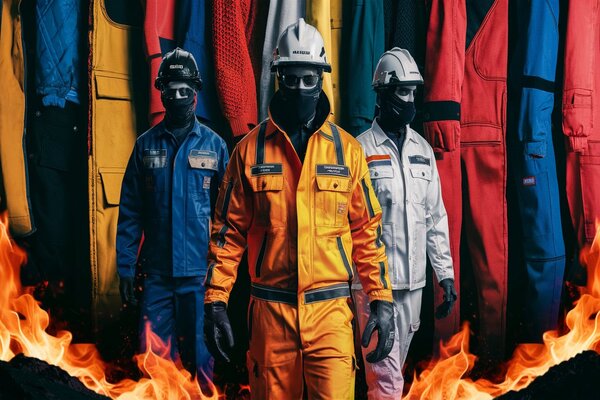Flame-Resistant Workwear: How To Avoid Common Pitfalls
Flame resistant workwear doesn't make you a Superman. There are possibilities of you getting injured. FR clothing reduces hazards but does not remove them, like other PPE. You could still face injury if it’s not used correctly.
Injuries are very common when you do work that includes fire and electricity. We need to know common mistakes we make while wearing flame-resistant (FR) workwear to maintain a safe working environment and why it is important to understand the basics.
NFPA Standards: The Backbone of Flame-Resistant Workwear
To select and use PPE effectively, guidelines are provided by the National Fire Protection Association (NFPA). Let us quickly look into the big picture:
1. NFPA 70E
Employers need to evaluate the workplace and define arc flash boundaries according to this standard. They need to choose the right PPE for both flame-resistant and arc-rated scenarios. It makes sure that the gear gives protection from specific electrical hazards.
2. NFPA 2112
This sets what should be the minimum performance criteria for flame-resistant workwear. It makes sure that the workwear provides proper protection on the job. This standard also checks if FR gear meets safety benchmarks properly.
3. NFPA 2113
It tells you the process of how to wear and maintain flame-resistant workwear. Proper care will help keep its qualities intact. Proper maintenance is important to keeping FR clothing effective for a long time.
Types of Flame-Resistant Workwear
You should understand the types of flame-resistant workwear before choosing one:
a). Coveralls
These are one-piece garments that cover your full body. You can wear it over personal clothes or base-layer flame-resistant workwear. They protect the worker’s entire body which includes the front, back, arms, and legs. Coveralls prevent sparks and hot materials from going through the waist area and offer continuous protection.
b). Parka Jackets
Parka jackets are zip-up garments worn over personal clothes or base-layer FR clothing. They protect from both cold weather and hot work environments. Parkas are the perfect combination of the necessary flame-resistant properties with insulation. This makes them versatile for various weather conditions.
c). Arc Suits
Arc suits are special garments that are designed to protect against burns from electrical arc flashes. They are created to resist burning, melting, and leakage, and reduce the risk of additional injuries from arc blasts. Arc suits are very essential for workers who work in high-voltage areas.
Top 5 Common Mistakes With Flame-Resistant Workwear
The best FR clothing cannot protect you if you do not use it properly. Here are some common mistakes that we make:
1. Non-FR Outer Layers
A stylish jacket or an extra layer for warmth looks harmless to you. But if it’s not flame-resistant, it can catch fire. A non-FR outer garment can still catch fire and cause danger even if your base layer is flame-resistant. You should invest in FR outerwear, like parkas, which provide both protection from the elements and fire.
2. Non-FR Inner Layers
Underlayers are equally important as outer layers. It can be dangerous to wear non-FR workwear because materials like polyester can burn quickly and even melt onto your skin. Make sure all layers, including undershirts, are flame-resistant or choose none at all if necessary.
3. Rolling Up Sleeves
When you roll up your sleeves, your arms are uncovered and fire or sparks can cause harm to them. To stay safe and stylish, choose flame-resistant workwear that is light in weight.
4. Leaving FR Clothing Unbuttoned or Unzipped
If you wear unbuttoned or unzipped FR clothing, it is similar to wearing them not at all. It will cause risk in your work field. You should not leave your FR gear unbuttoned or unzipped. Always wear your PPE fully fastened to protect yourself from potential hazards.
5. Untucked Shirts
Heat and flames can reach your skin if you leave your shirt untucked. This can cause severe burns. You should choose FR clothing with long shirttails. It will keep your shirt tucked securely into your pants. This will leave no gaps for heat or flames to penetrate.
Recognizing Explosive Hazards
Understanding explosive hazards is vital for safety:
1. Electrical Arc Flash
A massive release of electrical energy creates temperatures up to 20,000 degrees Celsius. Electricians and utility workers are particularly at risk of this condition. Proper flame-resistant workwear is essential to protect against these extreme conditions.
2. Flash Fire
A rapid, intense fire that spreads quickly through flammable vapours or dust without producing damaging pressure. Workers in the pharmaceutical, chemical, and refining industries need FR clothing that can handle such sudden fires.
3. Combustible Dust
Fine particles can catch fire and explode when spread in the air and exposed to a firing source. Workers in food processing, paper mills, and similar industries must use flame-resistant workwear that is designed to prevent burning and explosion.
End Notes
Fire and explosive hazards cause serious risks in various industries. They can lead to serious injuries or fatalities. It is important to maintain all the safety measures properly while wearing flame-resistant workwear. Make sure that you choose the right FR clothing and maintain it to provide effective protection.
Remember to:
- Wear flame-resistant outerwear.
- Avoid non-FR inner layers.
- Keep sleeves rolled down.
- Fasten all clothing properly.
- Tuck in shirts to prevent heat and flames from reaching your skin.
By keeping in mind these guidelines, you maximize your protection and maintain a safer working environment in the face of dangerous conditions.
UNITO is one of the top FR clothing manufacturers in India. We offer various types of workwear to protect the dynamic workforce from all kinds of safety hazards. We create high-quality workwear to ensure durability and longevity. Choose UNITO to give your workers safety gear to work efficiently.




